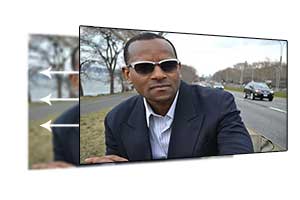If you’re new to photography, you’ve probably wondered what Portrait Mode is on your smartphone camera.
Well, your smartphone camera uses technological trickery to give your images the ‘look’ you get in a portrait shot using a dSLR camera.
So, let’s go over what it is, how it works and why you should use it.
What is Portrait Mode?
 Portrait mode, as it’s name suggests, is a collection of software algorithms that together, give you a pleasing portrait image.
Portrait mode, as it’s name suggests, is a collection of software algorithms that together, give you a pleasing portrait image.
Different smartphone manufacturers do it in different ways, but the basics are the same.
When you take an photo in portrait mode, the background is blurred, so that the person’s face draws the attention of the viewer.
It simulates background blur and the effect of bokeh, created when a portrait is taken with a dSLR camera. The face is sharp and the background is out of focus and non-distracting.
So, how does it do that?
How does Portrait Mode work?
There are two main ways your smartphone camera achieves this blur. If your smartphone has at least two cameras (two lenses on the back), it uses both. Almost all smartphone cameras have at least two different cameras, some have four! (not including the selfie camera)
 So, when you shoot an image in portrait mode, the software in your smartphone actually takes two images. One with the main camera and one with the second camera.
So, when you shoot an image in portrait mode, the software in your smartphone actually takes two images. One with the main camera and one with the second camera.
Then, using software algorithms, it merges these two images together as layers, one on top of the other.
Once the two images are lined up, it uses another algorithm (much like the way autofocus works), to isolate the person from the background. Then, it defocuses the background layer of the image.
This gives you a soft background and a sharp subject.
Essentially, each image in portrait mode is made up of two separate layers. And, because all of these adjustments are done electronically, you can usually change the level of blur later.
Open the image in your camera’s gallery and you should have access to aperture settings right there. By using the slider you can give the background more or less detail.
If your smartphone only has one camera, it takes a single image, then the algorithm does it’s thing on the one image. But remember, because there’s only one image, you won’t be able to adjust the background focus afterwards.
Is it worth using?
Portrait mode has come a long way over the last few years. Early versions were a bit hit-and-miss.
The first smartphone to introduce a portrait mode was the iPhone 7 plus. When the subject was in front of a fairly plain background, the results were very good.
Unfortunately, it struggled a bit with ‘busy’ backgrounds. Parts of the subject would be blurred, or sections of the background would be sharp. Although to be fair to Apple, a couple of updates later and it made a much better job of it.
However, the iPhone 7 plus was released six years ago, and things have greatly improved since then.
Portrait mode today is almost as good as you can achieve in most consumer range dSLR cameras. Plus, you get the added benefit of being able to adjust how much blur the background has, even after you’ve taken the photo.
Because a dSLR camera gets it’s soft background by using the focal length and a physical opening in the lens, it can’t be changed afterwards1.
Conclusion
I feel portrait mode is definitely worth considering if you want to blur out, or even just soften the background in your photo.
Provided your smartphone camera has at least two lenses, there really is nothing to lose. If you don’t like the result, simply change it by adjusting the aperture setting in the gallery2.
As portrait mode gets more advanced, it’s able to pick out other things as well. It was originally designed to be used on human portraits. But, some smartphone cameras can now pick out animals and some inanimate objects as well as human faces.
Give portrait mode a try in different situations and see what results you get. Experimentation is very often the key to some amazing images.

FOOTNOTES:
- Some minor changes can be made in post-processing (ie using Lightroom)
- Check that your smartphone camera has this functionality first. Some don’t 🙁

